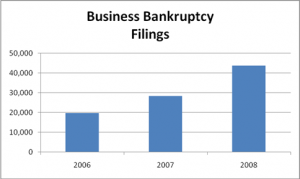|
|
|
Friday, June 19th, 2009
Last Friday I offered you a brain-stretching riddle. Did you get the answer?
You will recall that the shifty moneylender had put two black pebbles in the bag.
The girl put her hand into the moneybag and drew out a pebble. Without looking at it, she fumbled and let it fall onto the pebble-strewn path where it immediately became lost among all the other pebbles. Without looking at it, she fumbled and let it fall onto the pebble-strewn path where it immediately became lost among all the other pebbles.
‘Oh, how clumsy of me,’ she said. ‘But never mind, if you look into the bag for the one that is left, you will be able to tell which pebble I picked.’
Since the remaining pebble is black, it must be assumed that she had picked the white one. And since the money-lender dared not admit his dishonesty out of fear, the girl changed what seemed an impossible situation into an extremely advantageous one.
I like this story because it is a simple illustration of the difficulty of so-called thinking outside the box, but why is that?
Starting as young children we are praised for coloring inside the lines and praise for coloring inside the lines continues as we grow.
The lines we stay inside my not be apparent to an onlooker, but they are obvious to our chosen world. Fashion is a great example, the Goth look that is seen as so outside-the-box by many is framed with as many rules and lines as is any mainstream look.
Fred H Schlegel had a nice suggestion, but it depended on changing the basic nature of the villain and when looking for out-of-the-box solutions we rarely can change people’s basic nature.
Becky Robinson came closest; she was honest and said that she had seen a similar problem previously. But in her synthesizing Becky allowed the crook to take the active role, assuming he would act ethically to maintain his honor, but if he had honor he wouldn’t have cheated in the first place.
Did Becky win? You decide in comments.
Creativity requires us to step away from many of our own basic assumptions as well as going outside the lines dictated by our world.
Doing this is how we enlarge our box to encompass the universe. (My apologies, I just found that this link didn’t work last week.)
It takes effort and lots of practice, but the rewards more than justify the work.
Image credit: piblet on flickr
Posted in Business info, Innovation, Personal Growth | 7 Comments »
Friday, June 12th, 2009
I’ve always said that no one ever really thinks outside their box, they just keep enlarging it. Rather than reprinting these posts, please read three of them here.
And here’s a riddle for a bit of box stretching and Friday fun.
Many years ago in a small Indian village, a farmer had the misfortune of owing a large sum of money to a village moneylender. The moneylender, who was old and ugly, fancied the farmer’s beautiful daughter. So he proposed a bargain.
He said he would forgo the farmer’s debt if he could marry his daughter.
 Both the farmer and his daughter were horrified by the proposal. So the cunning money-lender suggested that they let providence decide the matter. He told them that he would put a black pebble and a white pebble into an empty money bag. Then the girl would have to pick one pebble from the bag. Both the farmer and his daughter were horrified by the proposal. So the cunning money-lender suggested that they let providence decide the matter. He told them that he would put a black pebble and a white pebble into an empty money bag. Then the girl would have to pick one pebble from the bag.
1) If she picked the black pebble, she would become his wife and her father’s debt would be forgiven.
2) If she picked the white pebble she need not marry him and her father’s debt would still be forgiven.
3) If she refused to pick a pebble, her father would be thrown into jail.
They were standing on a pebble strewn path in the farmer’s field. As they talked, the moneylender bent over to pick up two pebbles. As he picked them up, the sharp-eyed girl noticed that he had picked up two black pebbles and put them into the bag. He then asked the girl to pick a pebble from the bag.
Logically, there are three choices,
- The girl should refuse to take a pebble.
- The girl should show that there were two black pebbles in the bag and expose the money-lender as a cheat.
- The girl should pick a black pebble and sacrifice herself in order to save her father from his debt and imprisonment.
But is there a fourth and better way out of the dilemma?
Take a moment to share your idea in comments and if you’re correct I’ll send you a management book (chosen based on your interests). If more than one of you gets it right the winner will be chosen using random.org.
I’ll post the answer next Friday, be sure to come back and see if your mind achieved what the girl’s did.
Image credit: piblet on flickr
Posted in Business info, Innovation, Just For Fun | 10 Comments »
Saturday, June 6th, 2009
Everybody has a different approach to the current economic upheaval depending on their MAP (mindset, attitude, philosophy™).
 Some see calamity where others see opportunity. There’s a lot of confusion and still a number of fiddlers who continue as if nothing is wrong or different. Let’s take a look at some examples. Some see calamity where others see opportunity. There’s a lot of confusion and still a number of fiddlers who continue as if nothing is wrong or different. Let’s take a look at some examples.
We’ve been reading for more than 50 years about one type of survivalist—from those who built nuclear shelters to those who fled to the wilderness loaded with various weapons. Now comes a suburban version fueled by the economic meltdown.
While others see this as a time to push innovation to the extreme; witness the air-powered car—works for me!
Pity some of the affluent kids who are finding spending four or five thousand dollars (or more) on summer volunteer efforts overseas, but instead are having to work at more mundane jobs.
Honors have taken a big hit. All those glitterati studded fund raisers that honored this person or that are hurting, since far fewer are willing to pay for the honor. (What? You thought they were free?)
Apparently the fashion world doesn’t believe all the talk of the new frugality, since Tom Ford’s shorts cost $650 and Armani’s are $775. Prada’s are a steal at $465 or you can splurge on Thom Browne’s $1,495 seersucker man-skort.
Enjoy and have a great weekend!
Image credit: MykReeve on flickr
Posted in Just For Fun, Saturday Odd Bits | No Comments »
Wednesday, May 20th, 2009

Now take a look at a 2009 Wall Street wizard
Image credit: Combined Media on sxc.hu
Posted in Business info, Innovation, Wordless Wednesday | 1 Comment »
Tuesday, May 19th, 2009
Possibly the most difficult question for any is business:
“Is it time to pull the plug?”
Business Bankruptcies up over 100% since 2006
In this difficult economic environment, many businesses are answering that question simply, “yes.” As the chart below shows, business bankruptcy filings grew dramatically in 2008, up over 100% from 19,695 in 2006 to 43,546 in 2008.

This chart is deceptive, because the average annual number of business bankruptcy filings for the 28 years 1980-2008 is 52,667 and the number of filings in 2005 was 39,201. So the 43,000 filings in 2008 are 20% below the long-term average and just a little above the number in 2005. But, regardless of the long-term average, the short-term trend is up over 200%.
Time to Pull the Plug on My Business?
Setting aside statistics, the question at hand is real, personal, and immediate for many small business owners. As a professional business consultant, I work with several clients struggling with this question.
One of my clients generates approximately $3,000,000 in revenue and supports 25 employees. For the past two years, this company’s revenue has remained flat, with annual losses of $250,000 or so. This year revenues have declined and the owner has kept the monthly losses to $20,000 by reducing expenses. So far, so good, right?
Will the situation improve in the near future? Is a turn-around in sight with just a little more patience and persistence? When does persistence become stubbornness? When is it time to pull the plug? How do you know? Forgive this barrage of questions—this is an extremely difficult, emotional question for a business owner.
What Are Your Choices?
As a business unit manager, you have the opportunity and responsibility to make major changes in your business. 2% solutions don’t count.
What few significant changes can you make to improve the problems facing your business?
- Eliminating People Means Eliminating Work. You simply cannot eliminate people and leave the workload unchanged. How can you reorganize your business to reduce the work? Can you automate or outsource back-office services or sales? Can you move more functions online? Can you move your customers to self-service online? Can you use online order / payment to simplify the sales and collection processes?
- Don’t Eliminate Products. Eliminate Production Costs. Can you shift inventory and fulfillment services to suppliers or third parties?
- Don’t Eliminate Value. Eliminate Overhead. Do you need all the office space, telephones, equipment, and software? Eliminate, reduce, or find it for free.
- Grow Revenues. Be careful here, as increasing revenue is extremely difficult, especially in this recession economy. It’s easy to forecast big growth, only to be surprised three months later when the growth has not appeared on schedule. First, find a few customers for your services, and then forecast the growth based on their orders.
You Already Know the Answer
Three business aphorisms provide some insights into this question:
- The universe rewards action.
- Ready, fire, aim.
- Follow the money.
Taken as a set, they offer a road map to making this difficult decision.
If your business is struggling, then do something! The business (universe) will respond to your actions.
If the business situation is getting worse, you have limited time and budget to make meaningful changes. This is not the time to be shy. Take some dramatic action. That’s the “ready, fire” advice. Observe the result. Based on the result, quickly adjust your actions to improve the outcome (aim).
Finally, follow the money to your desired outcome. You know your budget for time and money. When either one runs out, you lose your freedom of action. Take action now, while you still have freedom to choose.
The biggest obstacles to meaningful business change are usually not intellectual understanding of the problem, or a lack of options, but emotion and fear.
For instance, most business owners truly care for their employees so layoffs are difficult. “What will my employees do without this job? How will they survive?” If you are considering major changes in business direction, fear raises similar questions about you; “How will my company survive if I make this change? What will I do with my life if my company fails, or if I have to shut it down?”
Together, emotional attachment and fear of the future create a paralysis, even in the face of clear impending disaster. When you wake up at 2 AM, what is on your mind? If you can get past the emotion and fear, I believe you already know the answer. “Don’t go wobbly,” as Margaret Thatcher famously advised George Bush senior when he was preparing for the first Iraq war. “I just don’t know,” is a cop-out.
What is Your Biggest Fear?
If your company is losing money each month, you must make changes. In this economy, your business will not get better by itself. What is the single change you fear the most?
Turn off the computer, put down the cell phone. Be still for a few moments, sitting with your fears and emotions. What is your biggest fear? Go there. Do it.
Wishing you the courage to make the difficult decisions,

Posted in Strategy | No Comments »
Tuesday, May 12th, 2009
Last week I described way to use an innovation wiki to juice creativity and garner ideas from all parts of the company. In the comments Jennifer Brown said, “…[is a] platform across the entire enterprise wherein the innovation “conversation” occurs – not just team by team/vertical by vertical, but across verticals that typically don’t talk to each other (hence leading to silos) or collaborate. …harness the power of the workforce, break the silo’d thinking of functional structures, and revolutionize business models.”
 I agree, but done with a small innovative twist an innovation wiki will break down not only departmental silos, but also the insidious horizontal silos that are based on position and education. I agree, but done with a small innovative twist an innovation wiki will break down not only departmental silos, but also the insidious horizontal silos that are based on position and education.
Personally, I loathe horizontal silos and consider them second only to politics on the corporate stupidity index.
More times than I can count I’ve seen the ideas of an engineer 1 or 2 discounted or ignored by the 3s and senior engineers—of course, that’s better than stealing them, although that happens, too.
The attitude seems to be one of ‘your brain is incapable of any creative thinking until you are at least at my pay grade’, which is idiotic.
People’s brains work differently; some see what is, others see possible improvements and a few see around corners, but that sight has little to do with position. Steve Jobs saw around the corner of the personal computer market before there was a personal computer market and certainly before he had any credibility what so ever.
Nor is it always about training and education. 20 odd years ago I redesigned two street intersection where I lived in San Francisco, but I didn’t suggest the solutions to the traffic engineers—I knew they wouldn’t listen because I have no training. Instead, I sneaked both ideas in through someone I know who was ‘accepted’ and both are still in effect today.
Silos are built of egos, which is why, vertical or horizontal, they’re so difficult to break down.
The best solution is for the CEO to build a culture that values everybody’s ideas equally, but technology offers a leg up on this.
When building your innovation wiki assign a random ID to each suggestion—sort of like match.com. They must be completely random so that level, grade and even department are totally obscured. Each idea has a different ID, so that when a person’s idea is used the next one is still anonymous; limit access of the actual name to a few top executives.
That anonymity truly levels the playing field and means that each idea is considered strictly on its merits, not on the merits of the person who thought of it. It also encourages people to way outside-the-box thinking and to post ideas without worrying about appearing silly, pushy or arrogant for offering ideas outside of their personal expertise.
Just be sure that the contributors of ideas that are used, whether all, in part or as a springboard to something else, receive plenty of public acknowledgement, kudos and anything else you’re in a position to do.
Your comments—priceless
Don’t miss a post, subscribe via RSS or EMAIL
Image credit: ZedBee|Zoë Power on flickr
Posted in Conflict, Ducks In A Row, Innovation | 6 Comments »
Saturday, April 18th, 2009
 Who’s innovating? Why is it important to stay focused on innovation? How are companies doing it in today’s economy? Who’s innovating? Why is it important to stay focused on innovation? How are companies doing it in today’s economy?
Check out Business Week’s story on the 50 Most Innovative Companies and don’t miss the side bar on the 25 most innovative companies you’ve probably never heard of.
A second innovation commentary comes from consultant Peter Bregman who offers up and interesting perspective on why it’s better to be David in this economy than Goliath.
Finally, what’s happening in compensation these days aside from Wall Street bankers with dubious bonuses?
Here’s the information for those of you wondering what CEOs are earning or whether it’s worth going for an MBA.
Image credit: MykReeve on flickr
Posted in Business info, Compensation, Culture, Innovation, Saturday Odd Bits, Strategy | No Comments »
Saturday, April 18th, 2009
 Who’s innovating? Why is it important to stay focused on innovation? How are companies doing it in today’s economy? Check out Business Week’s story on the 50 Most Innovative Companies and don’t miss the side bar on the 25 most innovative companies you’ve probably never heard about. Who’s innovating? Why is it important to stay focused on innovation? How are companies doing it in today’s economy? Check out Business Week’s story on the 50 Most Innovative Companies and don’t miss the side bar on the 25 most innovative companies you’ve probably never heard about.
A second innovation commentary comes from consultant Peter Bregman who offers up and interesting perspective on why It’s better to be David in this economy than Goliath.
What’s happening in compensation these days aside from Wall Street bankers with dubious bonuses? Here’s the information for those of you wondering what CEOs are earning or whether it’s worth going for MBA.
That’s it for this week. Have a wonderful weekend and keep your eye on the innovation ball—that’s really what pays.
Image credit: MykReeve on flickr
Posted in Business info, Compensation, Innovation, Leadership, Marketing | No Comments »
|
 Subscribe to
Subscribe to
MAPping Company Success
About Miki 
Clarify your exec summary, website, etc.
Have a quick question or just want to chat? Feel free to write or call me at 360.335.8054
The 12 Ingredients of a Fillable Req
CheatSheet for InterviewERS
CheatSheet for InterviewEEs™
Give your mind a rest. Here are 4 quick ways to get rid of kinks, break a logjam or juice your creativity!
Creative mousing
Bubblewrap!
Animal innovation
Brain teaser
The latest disaster is here at home; donate to the East Coast recovery efforts now!
Text REDCROSS to 90999 to make a $10 donation or call 00.733.2767. $10 really really does make a difference and you'll never miss it.
And always donate what you can whenever you can
The following accept cash and in-kind donations: Doctors Without Borders, UNICEF, Red Cross, World Food Program, Save the Children
*/
?>About Miki
About KG
Clarify your exec summary, website, marketing collateral, etc.
Have a question or just want to chat @ no cost? Feel free to write
Download useful assistance now.
Entrepreneurs face difficulties that are hard for most people to imagine, let alone understand. You can find anonymous help and connections that do understand at 7 cups of tea.
Crises never end.
$10 really does make a difference and you’ll never miss it,
while $10 a month has exponential power.
Always donate what you can whenever you can.
The following accept cash and in-kind donations:
|
 Without looking at it, she fumbled and let it fall onto the pebble-strewn path where it immediately became lost among all the other pebbles.
Without looking at it, she fumbled and let it fall onto the pebble-strewn path where it immediately became lost among all the other pebbles.



 Some see calamity where others see opportunity. There’s a lot of confusion and still a number of fiddlers who continue as if nothing is wrong or different. Let’s take a look at some examples.
Some see calamity where others see opportunity. There’s a lot of confusion and still a number of fiddlers who continue as if nothing is wrong or different. Let’s take a look at some examples.


 I agree, but done with a small innovative twist an innovation wiki will break down not only departmental silos, but also the insidious horizontal silos that are based on position and education.
I agree, but done with a small innovative twist an innovation wiki will break down not only departmental silos, but also the insidious horizontal silos that are based on position and education.
 Who’s innovating? Why is it important to stay focused on innovation? How are companies doing it in today’s economy?
Who’s innovating? Why is it important to stay focused on innovation? How are companies doing it in today’s economy? Who’s innovating? Why is it important to stay focused on innovation? How are companies doing it in today’s economy? Check out Business Week’s story on the
Who’s innovating? Why is it important to stay focused on innovation? How are companies doing it in today’s economy? Check out Business Week’s story on the 
